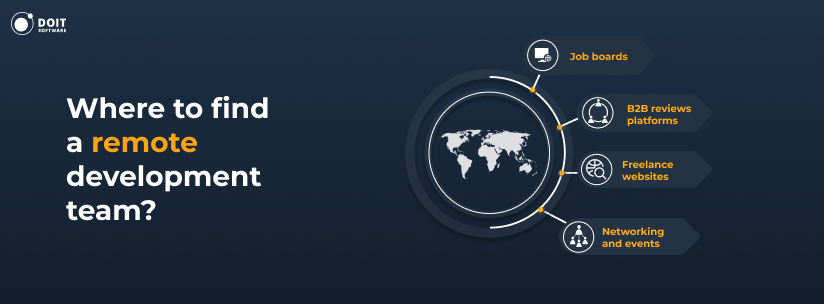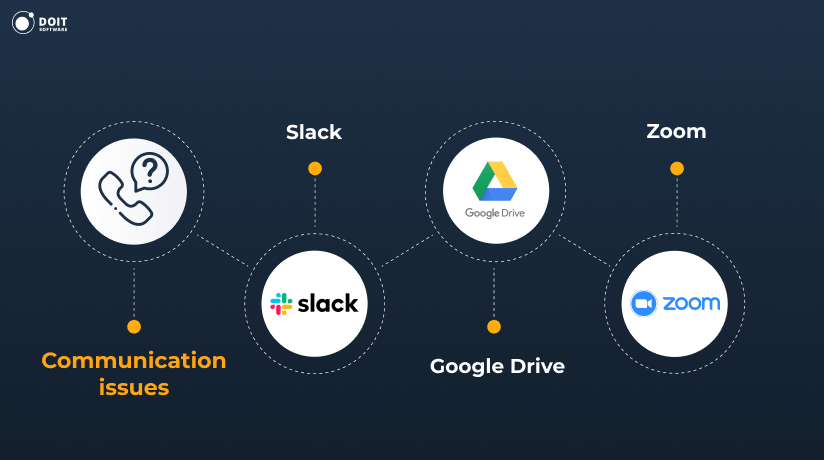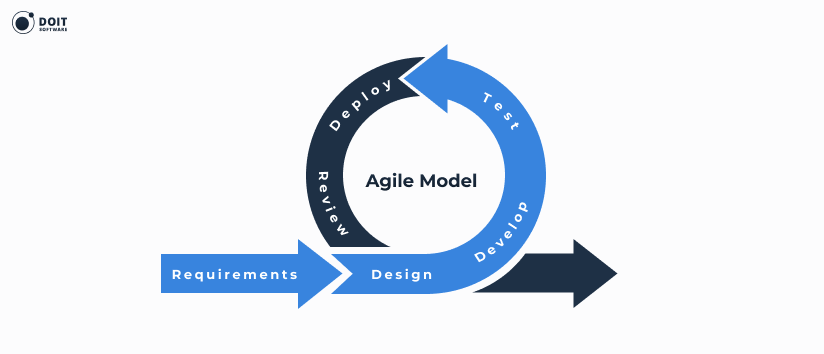The global coronavirus pandemic has forced many organizations worldwide, including tech giants such as Amazon, Meta, and Google, to switch to remote work. According to GitLab, more than 50% of remote employees only began working that way in 2020. And the exciting fact is that they enjoy such an approach. As of April 2025, 69% of IT employees in the US work remotely or in hybrid mode.
Thus, increasingly, IT companies have started using a remote development team model to achieve their business goals, such as launching a new product on time or improving the current one within a tight budget. But building and managing software teams remotely is challenging and even a bit scary. That is because your business may face multiple issues and risks regarding workflow optimization, communication barriers, or lack of motivation, etc.
Below, we will consider how to avoid potential problems when working with remote development team and ensure efficient project management. Let’s start!
Partnering with DOIT Software, you will get top-skilled remote developers to build the desired state-of-the-art product. Contact us to speed up your product development with a dedicated tech team.
A remote dedicated development team refers to a cooperation model in which a tech vendor provides a team to your company for your software product development and subsequent launch.

Here are some of the most critical characteristics that each remote development team has:
Western European or US-based startups hiring remotely is a common occurrence. But well-known global tech giants also leverage remote development and benefit from it. Here, we have created a small list of the most notable ones:

The most convenient way to hire a remote development team is to perform internet research, paying particular attention to the following resources:

The decision to hire a remote software development team will surely bring crucial benefits to your organization. Let’s define them briefly below.
Cost reduction is the first reason why companies want to hire a remote development team. For instance, a recent report states that “a typical U.S. employer saves an average of $11,000” per employee each year when hiring and managing remote development team. That is because they do not need to spend on office space, utilities, IT infrastructure, etc.
Because of the local talent shortage, hiring a skilled team of developers is advantageous. This eliminates existing geographical boundaries and provides worldwide access to a significant talent pool. So, if you run a startup and expect further growth, you should hire a remote custom software development team at a relatively low cost and simultaneously ensure good quality. Considering the global talent pool, you have the choice of either leading the hiring process yourself or collaborating with global hiring experts to build your team.
Your company may consider a staff augmentation model as an effective means to hire a remote development team. It offers enough scalability since you can obtain specialists depending on your project requirements. This enables you to scale up and down anytime if needed and provides unmatched flexibility.

What is staff augmentation, and why should your company use it?
Typically, hiring in-house software developers is time-consuming and costly. Recruiters should search and choose talent, interview candidates, and handle legal issues. Fortunately, the focus on core business tasks is among the critical advantages of a remote development team. That is because, in many cases, your vendor takes responsibility for providing the best tech specialists together with a dedicated project manager for managing a software development team effectively.
Understanding the most critical challenges related to remote team management can help your organization avoid specific impediments or address them efficiently. So, the three key barriers when managing a development team remotely are:
Lack of English knowledge, distance, cultural differences, or even an inadequate frequency of calls can affect communication with your remote software development team. These may also result in frustration and multiple misunderstandings and thus decrease productivity.

Solution: Apart from communicating frequently and promoting your remote development teams to improve their English, you can utilize some effective communication channels. For example, you can use the following helpful tools for managing a remote development team:
When you hire remote development team abroad, particularly in Asia or Eastern Europe, you must deal with the time difference. This challenge may take a lot of work to manage, mainly when you need to schedule meetings or discuss urgent and emerging issues.
Solution: Using Agile to manage remote team is crucial since using it includes having standard consultation sessions. Meanwhile, they can keep the work running smoothly and carefully manage everything when your in-house staff in the United States is still asleep. Also, if you hire a remote development team in a country with a 3-4 hours time difference, you may get an overlap between working hours.
If your organization has a complex project or your remote software development team is large, managing its productivity and keeping track of numerous individual tasks may become difficult. Besides, you might struggle with a lack of feedback from your remote software development specialists, which often results in misunderstandings and conflicts. To address these challenges effectively, consider implementing robust remote support solutions.
Solution: Your company can assign building a successful software development team and managing its activities to a dedicated project manager. That allows you to focus more on your core business tasks and growth. Also, you can utilize online project management tools such as Trello, Asana, or Jira to boost your remote development team’s productivity.

After analyzing the pros and cons of virtual teams, there is a need to compare in-house software development vs. outsourcing. Let’s check the comparison table below!
Objective
Traditional cooperation
Project delegation
Success definition
Achieving business goals
Completing the project according to the terms of of the contract
Project scope
Unclear
Determined in advance
Budget
Unlimited
Limited
Fit for
Long-term projects
Short-term projects
Costs
Higher
Lower
Management involvement
Mandatory
Can be covered by your vendor
Control
More
Less
Data security
Better
At risk
Scalability
Less
More
Seamless communication
Yes
May be difficult
Corporate culture
Yes
No
Productivity
Lower
Higher
One of the most popular remote hiring models is outstaffing.
Although you may understand how to hire remote development team located thousands of miles away from your office, you should also reconsider your approach to its management. Thus, we have created a comprehensive guide on how to manage development team working remotely. These relevant tips can help prevent any potential challenges between your in-house staff and remote teams and ensure all employees’ efficiency and satisfaction.
Your remote development team may consist of various specialists based on your business requirements. However, a typical team includes the following professionals:

After gathering specialists worldwide virtually, you should understand that they will not start showing their best performance from the very first day. Thus, when thinking about how to manage a software development team working remotely, you need to pay attention to building effective processes. After all, implementing a process-oriented approach is vital.
Therefore, you should manage your remote software development using Agile. For instance, the Agile Manifesto declares the following key principles:
Also, your organization can foster Agile within your remote development team by leveraging continuous integration, promoting knowledge sharing, and prioritizing communication.

How can you do that effectively? Here are some valuable recommendations:
Your task is to discuss general project goals and their critical pain points, not propose non-relevant solutions. You can propose relevant solutions only if needed – for instance, in advance, when there is a risk of failure, etc.
When managing development teams working remotely, you need to refrain from tracking all their steps and assigning minor tasks. Instead, it is crucial to encourage remote developers to organize their workflow and resolve emerging issues independently. That allows you to set determined priorities and communicate the reasons why it is necessary to focus on long-term objectives.
If you aim to manage software development efficiently, do not use people to complete tasks that a particular program can perform. This is because such a mundane routine can quickly kill your employees’ morale. So, automating various manual tasks is vital and helps ensure that your remote development team enjoys their work.

Why is it essential to have the proper project documentation? These documents include all the relevant functional and non-functional specifications, and the constraints that the engineers and QA professionals are required to use in order to start the development process. Thus, you should provide all the necessary project requirements since this allows for strictly outlining a product’s shared vision and common values.
Also, documentation is a must-have when you need to onboard a new person or substitute developers. This allows for proper knowledge transfer. But you may need help handling it – a reliable remote development team can assist you with this.
Leaving some project-related uncertainty for your remote software development specialists is inadmissible. You should guarantee a proper onboarding process if your organization aims to achieve the best possible results.
First, provide your remote development team with all the needed equipment. Make sure that they will have all the apps and software required for the job. Don’t forget to install one of the best antivirus software solutions to keep their workplaces secure.
Also, during this stage, you must provide your remote development team with all the critical project details and specifications, discuss ideas, and ensure that everyone on the team understands your project goals correctly.
To have smooth onboarding of your remote team, set up an e-learning platform to educate your employees about your product and its features. You can use a white label LMS if your company is not planning on building a custom one.
In addition, bringing more data and information to the process enables you to:
Lastly, during onboarding, you must share your working guidelines and agree on the project schedule, which is vital for team productivity.
In managing a remote development team, it’s crucial to have efficient communication and workflow optimization strategies. One fantastic approach is utilizing knowledge management (KM) tools. These KM tools can facilitate better information sharing and collaboration, leading to enhanced productivity and project outcomes. Besides addressing communication barriers, such tools are essential for organizing training materials, document storage, and keeping the team’s knowledge base accessible at all times.
In addition to that, providing convenient communication tools is essential for managing a remote development team. Today you can find many specific apps to stay in contact with your team members.
Here we will briefly describe some of the most popular programs for communication and divide them into two main groups:
You should be able to search for the necessary text easily and preserve it quickly. After all, text is often the key way of communication during a software development process.
Although video calls may sometimes be disadvantageous, they do bring the opportunity to conduct personal meetings. So you can explain your ideas and/or goals more effectively and establish a stronger connection with your remote development team.
You can also use remote support tools like TSplus for troubleshooting bugs. It can be useful to quickly and efficiently address almost any type of technical issue.
Good communication must be regularly conducted, so keep your remote development team organized. At the same time, frequent meetings are about something other than your desire to control everything. It would be best if you considered them as a tool to build trust, check the project’s progress, assist in removing emerging obstacles, and align the following plans.

Below, we have created a small list of regular meetings you can use to keep a team on the same page.
In addition, it is essential to always keep in touch with each team member. Thus, the best way is to arrange informal online meetings, one-on-ones. You can conduct such meetings weekly, but monthly would be a better option. However, if you want to establish an appropriate personal contact, do not focus on discussing business issues only.
Understanding how things are going on the project often takes time and effort. Therefore, you should track all the basic productivity metrics. That allows for the following:
It means that tracking enables your organization to obtain a detailed performance review. At the same time, remote developers can also identify the issues they must address. So, if you leverage tracking, you will get valuable information to discuss in personal meetings.
Here we have named two of the most popular process-and time-tracking tools you can utilize for your software development process:
You can also consider some other progress-tracking programs like Trello and ClickUp, as well as employee time tracking software. Although all of these solutions offer similar features, you may find the perfect fit depending on your team size, pricing plans, and/or user-friendliness.
Even though your company has always hired in-house developers, you should consider working with a remote development team. This is because if you can learn how to manage such employees effectively, you will obtain significant advantages, such as cost reduction and scalability. Since teams of skilled and reliable software engineers are dispersed worldwide, a separate geographical location will not be a factor that would compromise your product’s quality.
With the use of many collaborative solutions, video calling apps, and project management SaaS platforms, you will face no barriers when cooperating with your remote development team. And if you ensure proper management by clearly defining roles and responsibilities, building workflows, and creating documentation, the remote team will expand your expectations.
Need experienced remote software developers to deliver the best possible outcomes for your product development? Contact us and get your first CVs in the shortest terms.
You should follow some helpful tips to guarantee solid remote team management. This involves clarifying roles and responsibilities, building processes, creating the necessary documents, providing smooth onboarding, using collaboration software, conducting regular meetings, and tracking working hours.
When hiring a remote development team, you may face communication issues, time zone differences, and management difficulties. But you can address them efficiently by utilizing communication and project management software tools.
Building trust, focusing on results, and promoting employee accountability are all vital contributors to the remote team’s success. But you should also pay particular attention to choosing the proper communication channels and encouraging flexibility regarding working hours.










